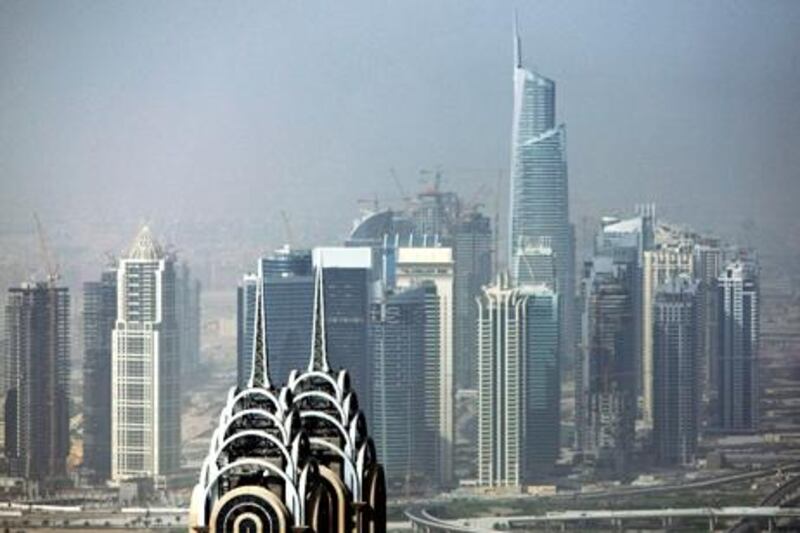Dubai faces a US$22 billion (Dh73.46bn) wall of debt coming due next year, according to an assessment of the emirate's finances by Moody's Investors Service, the ratings agency.
Most of the liability - some $20bn - is in the form of direct government debt. It stems from the financial assistance made available by Abu Dhabi in loans from the UAE Central Bank and other financial institutions during the Dubai World restructuring of 2009-2010.
But Moody's said that the improving economic and credit environment in Dubai, and high oil prices, make for a "buoyant" credit outlook for the emirate.
"We believe that the Government of Dubai along with its Abu Dhabi lenders will find an amicable solution [to the debt issue] such as an extension so that it will not create any liquidity pressure on Dubai," Moody's concluded.
The agency also said that there was a more positive outlook for some $2.13bn of Dubai non-financial rated debt also due for repayment next year, and it noted progress in restructurings involving Dubai Group, which owes $10bn to creditors, and Abu Dhabi's Al Jaber conglomerate, with liabilities of $4.5bn.
Moody's said that next year would be a "pivotal year" for Dubai. "The Government faces $20bn of maturing government obligations that it incurred in conjunction with the bailout of Dubai World in late 2009, an event that had wider regional repercussions and closed off GCC issuers' access to the debt markets.
"The way in which the Government of Dubai addresses this refinancing and the degree of transparency with which it updates the market on progress are likely to broadly influence investor sentiment," Moody's added.
There was a "weakness in the institutional framework" of Dubai that could cloud the picture relating to the debt repayments, Moody's said. "Little progress has been made on the legal framework for clarifying the legislation for insolvencies and debt restructuring."
Martin Kohlhase, the senior Middle East analyst at Moody's Dubai office, said: "There has been little progress too in terms of transparency, and Dubai has still not come up with a long-term debt strategy."
"In the unlikely event that the debts are not extended, it could have a knock-on effect for liquidity and the emirate's credit-worthiness."
There had, however, been an improvement in Dubai's credit ratings, which had allowed it to access international capital markets.
Rival rater Standard and Poor's said Dubai's government-related entities, such as Dewa, were finding it easy to lower their funding costs through tapping sukuk markets.
Paul-Henri Pruvost, an analyst at Standard and Poor's said: "This window of opportunity may continue into 2013 as long as this low interest rate environment persists."
However, Mr Pruvost acknowledged that local companies could not hope to take advantage of soaring demand for Islamic assets forever, "just as trees do not grow up to the skies", he said.
Moody's painted a benign picture of the Dubai economy, based on its assessment of proxy indicators of trade, transport and tourism.
It estimated that economic activity would grow by "low single digit percentages," roughly in line with government forecasts and in pace with growth in the emerging markets of the Group of 20 nations.
Although only a small proportion of Dubai's GDP is dependent on oil, Moody's said that "the oil price is nevertheless a good indicator of investor sentiment as high oil prices encourage investments from which Dubai's economy benefits through secondary trading effects". It forecast that Brent crude oil would trade above $90 per barrel this year and next, above the budget break-even price for the biggest GCC exporters.
Moody's also produced a report on sovereign debt in the Middle East and North Africa, which showed a "growing economic divergence" between countries since the global financial crisis and the Arab Spring. "There are stable sovereign credit ratings among oil-rich countries and downward rating pressure facing those most affected by the Arab Spring," it said.
Upheavals in some countries have shaken the region's social and political landscape, and conditions remain unsettled in Tunisia, Libya, Egypt, Syria and Yemen.
"At the same time, oil-rich countries of the GCC have ramped up social welfare spending to pre-empt discontent and address long-standing needs," Moody's said.
Qatar said yesterday that it would seek a prestigious AAA credit rating from agencies. One agency said ratings would be held at AA for the Arabian Gulf state as long as geopolitical risk remained in the region.
* with reporting by Gregor Stuart Hunter





